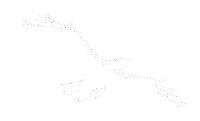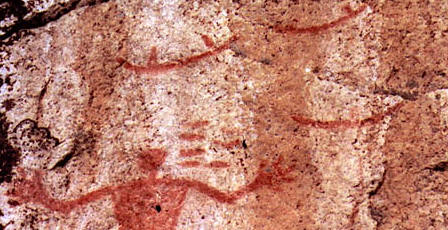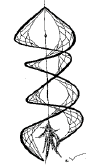CHAPTER VII.Preliminary remarks--Visit of Claude
Allouez to the Bay of Shag-a-waum-ik-ong, as known to the Ojibways--Definition
of "Wa-me-tig-oshe," the Ojibway name for Frenchman--Antique silver crucifix
found near La Pointe--Ancient prophecy foretelling the coming of the white
race--The singular dream of Ma-se-wa-pe-ga--He goes in search of the white
spirits--Finds them and returns to his people with presents--He makes a
second journey and returns with the fire-arms and fire-water--Anecdote of
the first trial and effect of fire-water--Anecdote of the effect of the
fire-arm among the Dakotas--Two white traders found starving on the island
of La Pointe--First white visitors to the Ojibways in the Bay of Shag-a-waum-ik-ong--Two
hundred years ago--Establishment of traders and priests at the Ojibway
village--Remarks, etc.
The era of their first knowledge of, and intercourse with
the white race, is one of most vital importance in the history of the
aborigines of this continent.
So far as their own tribe is concerned, the Ojibways have
preserved accurate and detailed accounts of this event; and the information
which their old men orally give on this subject, is worthy of much
consideration, although they may slightly differ from the accounts which
standard historians and writers have presented to the world, and which they
have gleaned from the writings of the enterprising and fearless old Jesuit
missionaries, and from the published narratives of the first adventurers who
pierced into the heart of the American wilderness. This source of
information may be considered as more reliable and authentic than the oral
traditions of the Indians, but as we have undertaken to write their history
as they themselves tell it, we will do so without respect to what has
already been written by eminent and standard authors. The writer is disposed
to consider as true and perfectly reliable, the information which he has
obtained and thoroughly investigated, on this subject, and which he will
proceed in this chapter to relate in the words of his old Indian informants.
A few preliminary remarks are deemed necessary, before
fully entering into the narrative of the Ojibway's first knowledge and
intercourse with his white brother.
Those who have carefully examined the writings of the old
Jesuit missionaries and early adventurers, who claim to have been the first
discoverers of new regions, and new people, in the then dark wilderness of
the west, or central America, have found many gross mistakes and
exaggerations, and their works as a whole, are only tolerated and their
accounts made matters of history, because no other source of information has
ever been opened to the public
It is a fact found generally true, that the first
adventurer who is able to give a flaming account of his travels, is handed
down to posterity as the first discoverer of the country and people which he
describes as having visited, when mayhap, that same region, and those same
people had been, long previous, discovered by some obscure and more modest
man, who, because he could not blazon forth his achievements in a book of
travels, forever loses the credit of what he really has performed.
Many instances of this nature are being daily brought to
light, and might be enumerated. Among others, Mr. Catlin claims in his book
(and is believed by all who do not know to the contrary), to have been the
first white man who visited the Dakota pipestone quarry, when in fact, that
same quarry had been known to, and visited by white traders for nearly a
century before Catlin saw it and wrote his book.
In the same manner also, Charles Lanman, of later
notoriety, claims to have been the first white man who visited the Falls of
the St. Louis River, when in fact Aitkin, Morrison, Sayer, and a host of
others as white as he, had visited, and resided for fifty years within sound
of those same falls.1 It is thus that a man who travels for the purpose of
writing a book to sell, and who, being a man of letters, is able to trumpet
forth his own fame, often plucks the laurels due to more modest and
unlettered adventurers. The allusion is to Lanman's Summer in the
Wilderness, published in New York, 1847.--E. D. N.
Mr. Bancroft in his standard "History of the United
States," mentions that in the year 1665, the enterprising and persevering
Jesuit missionary, Claude Allouez, with one companion, pushed his way into
Lake Superior and discovered the Ojibways congregated in a large village in
the Bay of Shag-a-waum-ik-ong, and preparing to go on a war party against
the Dakotas; that he resided two years among them, and taught a choir of
their youths to chant the Pater and Ave.
This is the first visit made by white men to this point on
Lake Superior, of which we have any reliable written testimony. The account
as given in Bancroft's "History" is not altogether corroborated by the
Ojibways. It is only through minute and repeated inquiry, that I have
learned the fact from their own lips, of this early visit of a "black gowned
priest," but not of his having resided with them for any length of time. And
they assert positively that it was many years after the first visit of the
white men to their village in the Bay of Shag-a-waum-ik-ong, that the
"priest" made his appearance among them. And I am disposed to doubt that as
long a stay as two years was made by Father Allouez among their people, or
that any of them learned to chant canticles, for the reason that the
Ojibways, who are so minute in the relation of the particulars of any
important event in their history, comprised within the past eight
generations, do not make any mention of these facts. It is probable that the
two years stay of this Jesuit in the Bay of Shag-a-waum-ik-ong, amounted to
an occasional visit from Sault Ste. Marie, or Quebec, which place had
already at this period, become the starting and rallying point of Western
French adventurers. (Mr. Bancroft erroneously wrote in the 14th edition of
the History of the United States, that Allouez "on the first day of October
arrived at the great village of the Chippewas in the Bay of Chagouamigon,"
but Mr. Warren is also wrong in his supposition.)
Allouez upon invitation of traders came with them to
Chagouamigon Bay in October 1665. At that time there was no permanent
Ojibway village beyond Sault Ste. Marie. He built a bark chapel on the
shores of the Bay between a village of Petun Hurons, and a village comprised
of three bands of Ottawas. On the 30th of August 1667, he returned to
Montreal, and in two days departed again for Lake Superior, where he
remained until 1669, when a mission was established among the Ojibways at
Sault Ste. Marie. In 1669 Marquette succeeded Allouez, in the words of the
Relation of 1669--70, "at Chagouamigong where the Outaouacs and Hurons
dwell." He remained with them until they were driven out of Lake Superior in
1671 by the Sioux.--E. D. N.
In those days there appears to have been a spirit of
competition and rivalry among the different sects of the Catholic
priesthood, as to who would pierce farthest into the western wilderness of
America to plant the cross.
Imagination in some instances, outstripped their actual
progress, and missionary stations are located on Hennepin's old map, in
spots where a white man had never set foot. That the Catholic priests
appeared amongst their earliest white visitors, the Ojibways readily
acknowledge. And the name by which they have ever known the French people is
a sufficient testimony to this fact, Wa-me-tig-oshe. For many years this
name could not be translated by the imperfect interpreters employed by the
agents of the French and English, and its literal definition was not given
till during the last war, at a council of different tribes, convened by the
British at Drummond's Isle. The several Ojibway interpreters present were
asked to give its definition. All failed, till John Baptiste Cadotte,
acknowledge to be the most perfect interpreter of the Algics in his time,
arose and gave it as follows: "Wa-mit-ig-oshe is derived from wa-wa, to
wave, and metig, wood or stick, and means literally, people or 'men of the
waving stick,' derived from the fact that when the French first appeared
among the Algonquins who have given them this name, they came accompanied
with priests who waved the Cross over their heads whenever they landed at an
Indian village."
The circumstance also is worthy of mention, that a few
years ago, an old Indian woman dug up an antique silver crucifix on her
garden at Bad River near La Pointe, after it had been deeply ploughed. This
discovery was made under my own observation, and I recollect at the time it
created quite a little excitement amongst the good Catholics of La Pointe,
who insisted that the Great Spirit had given this as a token for the old
woman to join the church. The crucifix was found about two feet from the
surface of the ground, composed of pure silver, about three inches long and
size in proportion. It has since been buried at Gull Lake, in the grave of a
favorite grandchild of the old Indian woman, to whom she had given it as a
plaything. (Another article in this volume shows that silver crosses were
sold by French and English traders.--E. D. N.)
The Ojibways affirm that long before they became aware of
the white man's presence on this continent, their coming was prophesied by
one of their old men, whose great sanctity and oft-repeated fasts, enabled
him to commune with spirits and see far into the future. He prophesied that
the white spirits would come in numbers like sand on the lakeshore, and
would sweep the red race from the hunting grounds, which the Great Spirit
had given them as an inheritance. It was prophesied that the consequence of
the white man's appearance would be, to the An-ish-in-aub-ag, an "ending of
the world." They acknowledge that at first their ancestors believed not the
words of the old prophet foretelling these events; but now as the present
generation daily see the foretold events coming to pass in all their
details, the more reflective class firmly believe that they are truly a
"doomed race." It was through harping on this prophecy, by which Te-cum-seh
and his brother, the celebrated Show-a-no prophet, succeeded so well in
forming a coalition among the Algic and other tribes, the main and secret
object of which, was the final extermination of the white race from America.
The account which the Ojibways give of their first
knowledge of the whites, is as follows:--
While still living in their large and central town on the Island of La
Pointe, a principal and leading Me-da-we priest, whose name was Ma-se-wa-pe-ga
(whole ribs), dreamed a dream wherein he beheld spirits in the form of men,
but possessing white skins and having their heads covered. They approached
him with hands extended and with smiles on their faces. This singular dream
he related to the principal men of the Ojibways on the occasion of a grand
sacrificial feast to his guardian dream-spirit. He informed them that the
white spirits who had thus appeared to him, resided toward the rising sun,
and that he would go and search for them. His people tried to dissuade him
from undertaking what they termed a foolish journey, but firm in his belief,
and strong in his determination, he was occupied a whole year in making
preparations for his intended journey. He built a strong canoe of birch bark
and cedar wood; he hunted and cured plenty of meat for his provisions; and
early in the spring when the ice had left the Great Lakes, and he had
completed his preparations, Ma-se-wa-pe-ga, with only his wife for a
companion, started on his travels in quest of the white spirits whom he had
seen in his dream.
conclude chapter 7
1
- 2
- 3
- 4
- 5
- 6
- 7
- 8
- 9
- 10
11
- 12
- 13
- 14
- 15
- 16
- 17
- 18
- 19
- 20
21
- 22
- 23
- 24
- 25 - 26 - 27 - 28 - 29 - 30
White Eagle Soaring: Dream Dancer of the 7th Fire








 Get
a course to promote your business online, explode your sales
Get
a course to promote your business online, explode your sales Get
software to promote your business online in less time
Get
software to promote your business online in less time Get
software to streamline your business and run it hands free.
Get
software to streamline your business and run it hands free.